Driving in Icy and snowy weather
Winter is fast approaching, and it can bring some treacherous driving conditions with it, how will this affect my driving? Have you just passed the driving test? Or perhaps you are still learning with friends and family? Bad weather can change the way you drive and can also come with some responsibilities you may not have considered. Hopefully, this blog will give you a few tips on how to keep yourself and everyone else safe this winter!
First things first
The best way of staying safe on the roads when there is snow or ice is only drive when you absolutely must. Avoid making non-essential journeys when ever possible, but if you need to drive here are some handy tips and things you should know.
Things to do before you drive away
Check your planned route make sure it is clear and there are no delays.
Check the weather forecast and see if any further bad weather is expected.
You must be able to see clearly, it is your legal responsibility to make sure all the snow and ice is removed from all your windows, don’t leave patches of ice or snow on the sides of the windows you need it completely clear.
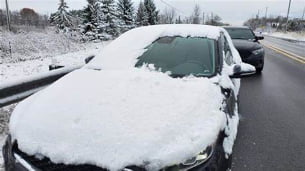
Not a good enough job, perhaps a bit more effort!
Can I just pour boiling water on my frozen windscreen I hear you ask?
Nope, seriously bad Idea that one. Extreme cold, extreme heat and glass are not a good combination for starters you can cause the windscreen to crack and you will also end up with pools of water on the floor around your car, which will freeze and cause a slip hazard.
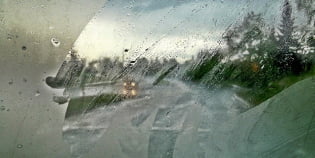
Above is a picture of a badly demisted windscreen, driving like this is an offence in the UK
Make sure all your windows are demisted thoroughly before you move away, when you sit in your car your breath will change the temperature of the interior of the vehicle and this can cause the window to mist up. Make sure you can see clearly.
Remove all snow that might fall off into the path of other road users, do not leave thick snow on the roof of your car it can slip and block your view or hit someone behind you.
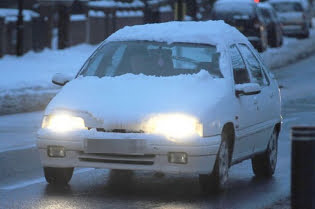
As the car starts to heat up all that snow on the bonnet and roof will melt and start to slide, the snow on the bonnet can slip and can obscure the lights and front number plate, while the snow on the roof will slip in front of the windscreen, which needless to say does not help with visibility.
You must ensure that lights are clean and number plates are clearly visible and legible, ice and snow can obscure other people’s view of your lights. Also make sure the mirrors are clear and you can see the road behind you clearly
When you are on the move
Now we all know snow and ice is slippery, and that’s makes skidding a higher risk than normal, always remember that the problems do not always come from you skidding it may be from someone else who is not paying as much attention as they should or are taking unnecessary risks.
Things to do that can keep you safe
Drive with care, even if the roads have been treated.
Keep well back from the road user in front as stopping distances can be ten times greater than on dry roads.
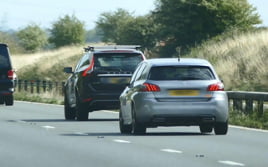
This is too close even for dry roads
Drive particularly carefully on bends, this is where most people will lose control of their vehicle. Slow down before you reach a bend avoid heavy breaking and any sudden actions while you are going around the corner.
If you drive a manual car, try and keep your gear as high as possible this will help you avoid wheel spinning, use the accelerate and brake very gently.
Not all ice is visible
Be aware of black ice. It is not always visible and so can be an even greater hazard for both motorists and pedestrians. Black ice may be formed when rain or drizzle fall on a road surface which is at a temperature below zero.
Snow can cover the ice, if you are driving on fresh snow remember that there may be ice under the fresh snow.
Salt spreading vehicles
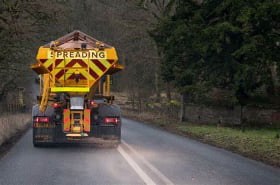
Salt spreading in action
Most local authorities will treat the main roads by spreading salt on them to stop ice from forming. Vehicles like the one above is used to spread the salt. Be careful when driving behind them or driving past them as salt will hit your car, avoid over taking them, they are there because it is icy so over taking is not always the best idea. If need to overtake make sure the road ahead is empty before beginning the manoeuvre.
Skidding
If the worst happens and you do start to skid there are a few things you can do to help bring your car under control. As the skid begins gently ease off the accelerator and avoid braking. If braking is necessary, pump the brakes do not slam them on, slamming the breaks will only lock the wheels and make the skid worse.
Snow can cover the road markings and road signs
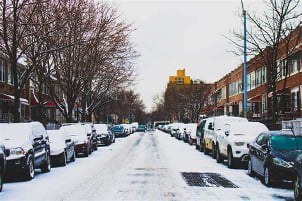
As you can see the snow covering the road makes any road markings invisible, but you are still responsible for abiding by U.K road law.
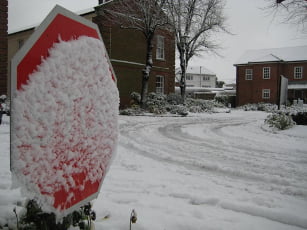
A snow covered stop sign
The reason stop signs are octagonal in shape is so they can be identified even when they are covered in snow. Not all signs are as helpful so make sure you take extra care when dealing with road markings and signs during heavy snow.
Remember the best way to avoid problems when driving in wintery conditions is to not drive at all. However, if you need to then take note of some of the things I have mentioned, and it should help keep you safe.
Keep driving, stay safe and I hope to see you next time.
Graeme Howard
Franchise manager
Union school of motoring
graeme@unionschoolofmotoring.co.uk
